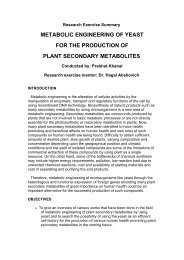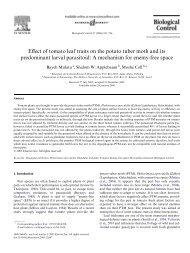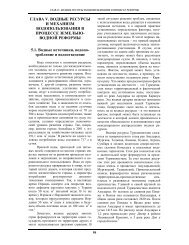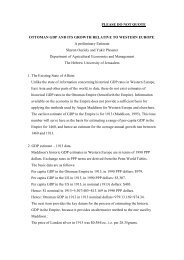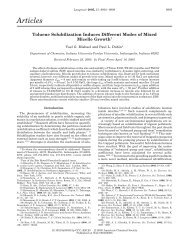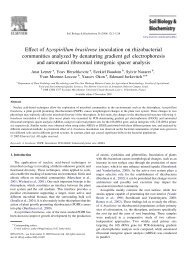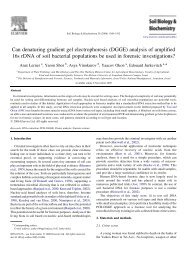Neurokinin Bs and neurokinin B receptors in zebrafish- potential role ...
Neurokinin Bs and neurokinin B receptors in zebrafish- potential role ...
Neurokinin Bs and neurokinin B receptors in zebrafish- potential role ...
Create successful ePaper yourself
Turn your PDF publications into a flip-book with our unique Google optimized e-Paper software.
explored the genomic locations of tac3 <strong>receptors</strong> <strong>in</strong> humans <strong>and</strong><br />
various fish species (Fig. S4 C <strong>and</strong> D). In human, TAC3R is<br />
located on chromosome 4, whereas <strong>in</strong> <strong>zebrafish</strong>, fugu (Takifugu<br />
rubripes), medaka (Oryzias latipes), <strong>and</strong> tetraodon (Tetraodon<br />
nigroviridis) tac3ra are located on chromosome 1, unplaced<br />
(UN), 1, <strong>and</strong> 18, respectively. The nearest neighbor<strong>in</strong>g gene<br />
(cnga2) of the <strong>zebrafish</strong> tac3ra gene is nonsyntenic with human,<br />
but syntenic with the medaka, fugu, <strong>and</strong> tetraodon. The nextupstream<br />
neighbor<strong>in</strong>g genes (bdh2, nhedc2, <strong>and</strong> cisd2) were<br />
found <strong>in</strong> similar locations <strong>in</strong> all analyzed species (Fig. S4C). The<br />
human genome lacks tac3rb, which is present <strong>in</strong> tetraodon, fugu,<br />
<strong>and</strong> medaka. The next-upstream neighbor<strong>in</strong>g genes <strong>in</strong> the<br />
<strong>zebrafish</strong> (acy3.1, acy3.2, cldnd, <strong>and</strong> glb1) were found <strong>in</strong> reverse<br />
order <strong>in</strong> the tetraodon (Fig. S4D). Tac3rc had no discernible<br />
synteny to any other family members. The presence of two forms<br />
of NKB [<strong>in</strong> <strong>zebrafish</strong> <strong>and</strong> salmon (salmo salar)] <strong>and</strong> two forms of<br />
cognate receptor genes <strong>in</strong> lower-vertebrate species supports the<br />
hypothesis of two rounds of genome duplication followed by<br />
degeneration <strong>and</strong> complementation of the genes. We conclude<br />
that the synteny is better with<strong>in</strong> fish than with mammals; moreover,<br />
fish tac3 <strong>and</strong> tac3r have conserved synteny with the human<br />
genome, consistent with orthology.<br />
Tissue Distribution of tac3 <strong>and</strong> tac3 Receptors <strong>in</strong> Zebrafish. To elucidate<br />
the physiological <strong>role</strong>s of the NKB/NKBR signal<strong>in</strong>g system,<br />
we next exam<strong>in</strong>ed the tissue distribution of both lig<strong>and</strong>s<br />
(tac3a, tac3b) <strong>and</strong> <strong>receptors</strong> (tac3ra, tac3rb) mRNAs <strong>in</strong> <strong>zebrafish</strong><br />
by means of real-time PCR analysis, accord<strong>in</strong>g to Biran et al.<br />
(15). We dissected the <strong>zebrafish</strong> bra<strong>in</strong> <strong>in</strong>to three parts, of which<br />
the anterior part conta<strong>in</strong>s the telencephalon, the midbra<strong>in</strong> conta<strong>in</strong>s<br />
the optic tectum, diencephalon, <strong>and</strong> hypothalamus <strong>and</strong> the<br />
h<strong>in</strong>dbra<strong>in</strong>, the medulla oblongata <strong>and</strong> cerebellum. We mostly<br />
detected tac3a mRNA <strong>in</strong> the midbra<strong>in</strong> <strong>and</strong> tac3b mRNA was<br />
found ma<strong>in</strong>ly <strong>in</strong> the forebra<strong>in</strong>. Both tac3a <strong>and</strong> tac3ra were<br />
expressed <strong>in</strong> the pituitary (Fig. 2A), collaborat<strong>in</strong>g f<strong>in</strong>d<strong>in</strong>gs <strong>in</strong><br />
mammals where NKB <strong>and</strong> NKBR were expressed <strong>in</strong> the median<br />
em<strong>in</strong>ence, which is miss<strong>in</strong>g <strong>in</strong> fish (6). tac3rb was expressed <strong>in</strong> the<br />
forebra<strong>in</strong> <strong>and</strong> was highest <strong>in</strong> the ovary. Different types of tac3<br />
<strong>and</strong> tac3r were expressed <strong>in</strong> the ovary <strong>and</strong> testis (Fig. 2A). Different<br />
levels of expression of tac3 <strong>and</strong> tac3r types were found <strong>in</strong><br />
extrabra<strong>in</strong> tissues (Fig. S5). The expression patterns of these<br />
genes <strong>in</strong> the bra<strong>in</strong>-pituitary-gonad axis further support the <strong>potential</strong><br />
<strong>role</strong> of the NKB system <strong>in</strong> fish reproduction.<br />
Gene Expression of the NKB/NKBR System Dur<strong>in</strong>g Sexual Maturation.<br />
Because it is known that the mammalian NKB/NKBR system is<br />
<strong>in</strong>volved <strong>in</strong> reproduction, <strong>and</strong> especially <strong>in</strong> puberty <strong>in</strong>itiation<br />
(16), we aimed to exam<strong>in</strong>e whether the pisc<strong>in</strong>e system fulfills<br />
a similar <strong>role</strong>. We used real-time PCR to evaluate the expression<br />
profiles of the zfNK<strong>Bs</strong> <strong>and</strong> their receptor mRNAs <strong>in</strong> the bra<strong>in</strong><br />
dur<strong>in</strong>g several development stages. Expression of tac3a mRNA<br />
was low at 2–4 wk postfertilization (wpf) (Fig. 2B); it then<br />
gradually <strong>in</strong>creased, peaked at 8 wpf, when the <strong>zebrafish</strong> go<br />
through puberty, <strong>and</strong> subsequently decreased by 12 wpf (Fig.<br />
2B), when the gonads conta<strong>in</strong>ed clear, well-developed oocytes or<br />
A B<br />
spermatozoa (15). The expression of the tac3b, tac3ra, <strong>and</strong> tac3rb<br />
mRNAs <strong>in</strong> the <strong>zebrafish</strong> bra<strong>in</strong> was low <strong>and</strong> did not change dur<strong>in</strong>g<br />
sexual maturation. The <strong>in</strong>crease of tac3a mRNA toward puberty,<br />
consistent with kisspept<strong>in</strong> signal<strong>in</strong>g <strong>in</strong>itiat<strong>in</strong>g puberty (15, 17),<br />
may <strong>in</strong>dicate a possible <strong>in</strong>volvement of the NKB/NKBR system<br />
<strong>in</strong> controll<strong>in</strong>g puberty.<br />
Localization of Embryonic tac3a Cells by Whole-Mount <strong>in</strong> Situ Hybridization.<br />
The first appearance of tac3a expression was detected at 3<br />
d postfertilization (dpf) <strong>in</strong> the right habenula nuclei <strong>and</strong> the midbra<strong>in</strong><br />
(Fig. 3 A, F, <strong>and</strong>K). The earliest stage that the signal was<br />
observed <strong>in</strong> the left habenula was at 4–5 dpf, when the signal <strong>in</strong>tensity<br />
<strong>in</strong> the right habenula <strong>and</strong> midbra<strong>in</strong> <strong>in</strong>creased, probably<br />
reflect<strong>in</strong>g <strong>in</strong>creased cell numbers (Fig. 3 B, C, G, H, L, <strong>and</strong>M). In<br />
addition, there was expression <strong>in</strong> the h<strong>in</strong>dbra<strong>in</strong>. Analysis of elderly<br />
larvae (7 <strong>and</strong> 9 dpf) revealed decreased tac3a signal <strong>in</strong>tensity (Fig. 3<br />
D, E, I, J, N,<strong>and</strong>O), <strong>and</strong> at 12 dpf it was barely detected. No signal<br />
was observed at any stage by use of the tac3a sense riboprobe.<br />
Dur<strong>in</strong>g embryogenesis tac3a was dom<strong>in</strong>antly expressed <strong>in</strong> the righthabenula<br />
nuclei, but <strong>in</strong> adults it was expressed <strong>in</strong> both habenular<br />
lobes (Fig. 3P). This asymmetrical expression of tac3a <strong>in</strong> the<br />
habenula is consistent with previous f<strong>in</strong>d<strong>in</strong>gs that the habenula <strong>in</strong><br />
<strong>zebrafish</strong> displayed left-right asymmetries <strong>in</strong> gene expression (18,<br />
19). Interest<strong>in</strong>gly, it was shown that neurons appear sooner <strong>in</strong> the<br />
left than <strong>in</strong> the right habenula (20). Neuronal organization asymmetries<br />
<strong>in</strong> the epithalamus (i.e., habenular nuclei <strong>and</strong> p<strong>in</strong>eal complex)<br />
are well known among vertebrates (21).<br />
Localization of tac3a mRNA <strong>in</strong> the Bra<strong>in</strong> of Adult Zebrafish. By us<strong>in</strong>g<br />
<strong>in</strong> situ hybridization (ISH) techniques to determ<strong>in</strong>e the localization<br />
of tac3a mRNA <strong>in</strong> the <strong>zebrafish</strong> bra<strong>in</strong>, we detected tac3a mRNAexpress<strong>in</strong>g<br />
neurons <strong>in</strong> the habenula (Fig. 3P), where kisspept<strong>in</strong> 1<br />
(kiss1) was previously shown to be expressed (22). Tac3a was also<br />
detected along the periventricular hypothalamus (Fig. 3 Q <strong>and</strong> R),<br />
<strong>in</strong> the periventricular nucleus of the posterior tuberculum (Fig. 3Q),<br />
<strong>and</strong> <strong>in</strong> the posterior tuberal nucleus (Fig. 3R). These bra<strong>in</strong> nuclei<br />
were previously found to express other important neuropeptides<br />
that regulate reproduction (17, 22), metabolism (23), <strong>and</strong> stress<br />
(24). In the mammalian ARC, KISS1 neurons that coexpress NKB<br />
<strong>and</strong> dynorph<strong>in</strong> were hypothesized to be a central node through<br />
which <strong>potential</strong> stress, metabolic <strong>and</strong> photoperiodic signals regulate<br />
GnRH release (25). The nuclear lateralis tuberis is considered as the<br />
pisc<strong>in</strong>e structure homologous to the mammalian ARC (23, 26). The<br />
localization of tac3a, kisspept<strong>in</strong>2(kiss2), kiss1 receptor b (kiss1rb),<br />
lept<strong>in</strong> receptor, melan<strong>in</strong>-concentrat<strong>in</strong>g hormone (MCH) 2 <strong>and</strong> two<br />
MCH1 <strong>receptors</strong>, Urotens<strong>in</strong> I, corticotrop<strong>in</strong>-releas<strong>in</strong>g factor, <strong>and</strong><br />
corticotrop<strong>in</strong>-releas<strong>in</strong>g factor-b<strong>in</strong>d<strong>in</strong>g prote<strong>in</strong> to the ventral zone of<br />
the periventricular hypothalamus (Fig. 3Q) (17,22–24, 26) might<br />
suggest that not all neuropeptide pathways are as conserved as<br />
formerly thought. This suggestion is supported by the recent f<strong>in</strong>d<strong>in</strong>gs<br />
that kiss2 is not expressed <strong>in</strong> the <strong>zebrafish</strong> nuclear lateralis tuberis,<br />
<strong>and</strong> that kiss2 neurons of the periventricular hypothalamus do not<br />
directly <strong>in</strong>nervate the <strong>zebrafish</strong> pituitary (22). F<strong>in</strong>ally, the close<br />
similarity between the expression patterns of <strong>zebrafish</strong> kisspept<strong>in</strong><br />
genes <strong>and</strong> <strong>zebrafish</strong> tac3a suggests a possible <strong>in</strong>teraction between<br />
Fig. 2. Expression of <strong>zebrafish</strong> tac3a, tac3b,<br />
tac3ra, or tac3rb mRNA <strong>in</strong> various parts of the<br />
bra<strong>in</strong> (A) <strong>and</strong> changes <strong>in</strong> <strong>zebrafish</strong> tac3a at various<br />
ages toward puberty (B) as determ<strong>in</strong>ed by<br />
real-time PCR. The relative abundance of the<br />
mRNAs was normalized to the amount of elongation<br />
factor 1 α (ef1α) by the comparative<br />
threshold cycle method; the comparative threshold<br />
reflects the relative amount of the transcript.<br />
Results are means ± SEM (n = 11–15). Means<br />
marked with different letters differ significantly<br />
(P < 0.05).<br />
Biran et al. PNAS | June 26, 2012 | vol. 109 | no. 26 | 10271<br />
AGRICULTURAL<br />
SCIENCES






